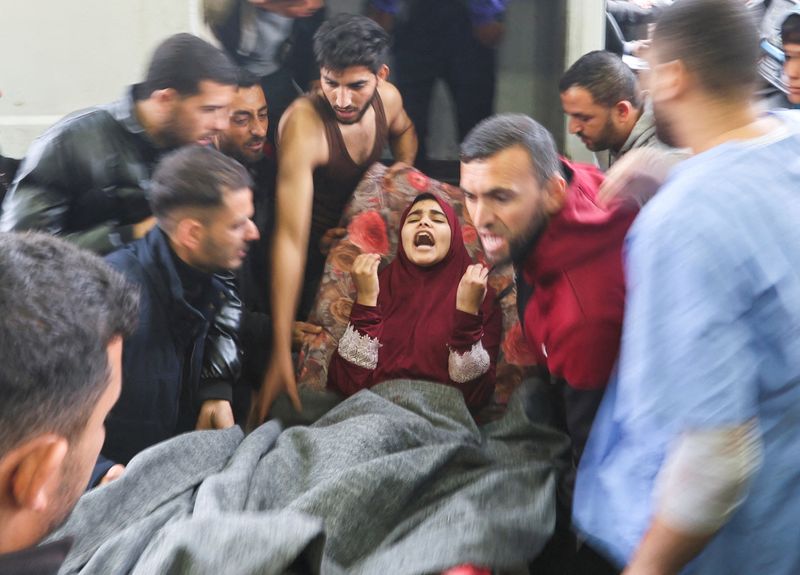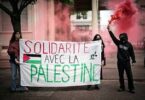GAZA (Reuters): Israeli forces stormed southern Gaza’s main city on Tuesday in what they called the most intense day of combat in five weeks of ground operations against Hamas militants, and hospitals struggled to cope with scores of Palestinian dead and wounded.
In what appeared to be the biggest ground assault in Gaza since a truce with Hamas unravelled last week, Israel said its troops – who were backed by warplanes – had reached the heart of Khan Younis and were also surrounding the city.
“We are in the most intense day since the beginning of the ground operation,” the commander of the Israeli military’s Southern Command, General Yaron Finkelman, said in a statement.
He said Israeli forces were also fighting in Jabalia, a large urban refugee camp and Hamas hotbed in northern Gaza next to Gaza City, and in Shuja’iyya, east of the city.
“We are in the heart of Jabalia, in the heart of Shuja’iyya, and now also in the heart of Khan Younis,” he said.
Hamas’ armed wing, the al Qassam Brigades, said its fighters had destroyed or damaged 24 Israeli military vehicles and snipers had killed or wounded eight Israeli soldiers in ongoing clashes in various areas of Khan Younis.
Separately, Gaza health officials said large numbers of people were killed in an Israeli strike on houses in Deir al-Balah, north of Khan Younis. Dr Eyad Al-Jabri, head of the Shuhada Al-Aqsa Hospital there, told Reuters at least 45 were killed. Reuters could not reach the area or confirm the toll.
After days of ordering residents to flee the area, Israeli forces dropped new leaflets on Tuesday with instructions to stay inside shelters during the assault.
“For your safety, stay in the shelters and the hospitals where you are. Don’t get out. Going out is dangerous. You have been warned,” said the leaflets, addressed to residents of six districts amounting to around a quarter of Khan Younis.
“Sixty days after the war began, our forces are now encircling the Khan Younis area…,” said Lieutenant General Herzi Halevi, chief of Israel’s General Staff, referring to the Oct. 7 Hamas incursion into Israel that triggered the conflict.
“We have secured many Hamas strongholds in the northern Gaza Strip, and now we are operating against its strongholds in the south,” Halevi told a press conference.
The Israelis, who largely seized Gaza’s northern half last month before pausing for the week-long truce, say they are now extending their ground offensive to the south of the enclave. They believe Hamas commanders they aim to eliminate are holed up in part of a vast underground tunnel network in the territory.
Israel unleashed its campaign in retribution for an attack on Oct. 7 by Hamas fighters who rampaged through Israeli towns, killing 1,200 people and seizing 240 hostages, according to Israel’s tally.
Since then more than 15,900 Palestinians are confirmed to have been killed by Israeli air and strikes and other actions, and the toll is rising each day, according to Gaza health officials. Thousands more are missing and feared buried under rubble.
‘DIFFICULT’ SECOND STAGE OF WAR
“We’re moving ahead with the second stage now. A second stage that is going to be difficult militarily,” Israeli government spokesperson Eylon Levy said.
Israel, he added, is open to “constructive feedback” on reducing harm to civilians as long as the advice is consistent with its aim of destroying Gaza’s ruling Islamist movement.
The United States on Tuesday again pressed Israel, its clsoe ally, to uphold international humanitarian law and do more to reduce harm to civilians in the war’s next phase. Despite the mounting death toll, it said Israel was now showing some receptiveness to the calls.
Israel says the blame for civilian casualties largely falls on Hamas fighters for operating in residential areas, including from underground tunnels that can be destroyed only with huge bombs. Hamas denies using human shields.
Israeli bombardments have driven 80% of Gaza’s 2.3 million residents from their homes, most fleeing south. Crowded southern areas are now sheltering triple their usual population.
At Khan Younis’ main Nasser hospital, the wounded arrived by ambulance, car, flatbed truck and donkey cart after what survivors described as a strike on a school being used as a shelter for the displaced.
Inside a ward, almost every inch of floor space was taken up by the wounded, with medics hurrying from patient to patient while relatives wailed.
A doctor carried the small limp body of a dead boy in a tracksuit and placed him in a corner, arms splayed across the blood-smeared tile. On the floor nearby, surrounded by discarded bandages and rubber gloves, lay a wounded boy and girl, their limbs tangled with the stands holding IV drips in their arms.
Two young girls were being treated, still covered in dust from the collapse of the house that had buried their family.
“My parents are under the rubble,” sobbed one. “I want my mum, I want my mum, I want my family.”
Since the truce collapsed, Israel has been posting an online map to tell Gazans which parts of the enclave to evacuate. Khan Younis’ eastern quarter was marked on Monday, home to hundreds of thousands of people, many of whom took flight on foot.
Gazans say there is no safe place, with remaining towns and shelters already overwhelmed, and Israel continuing to bomb the areas where it is telling people to go.







